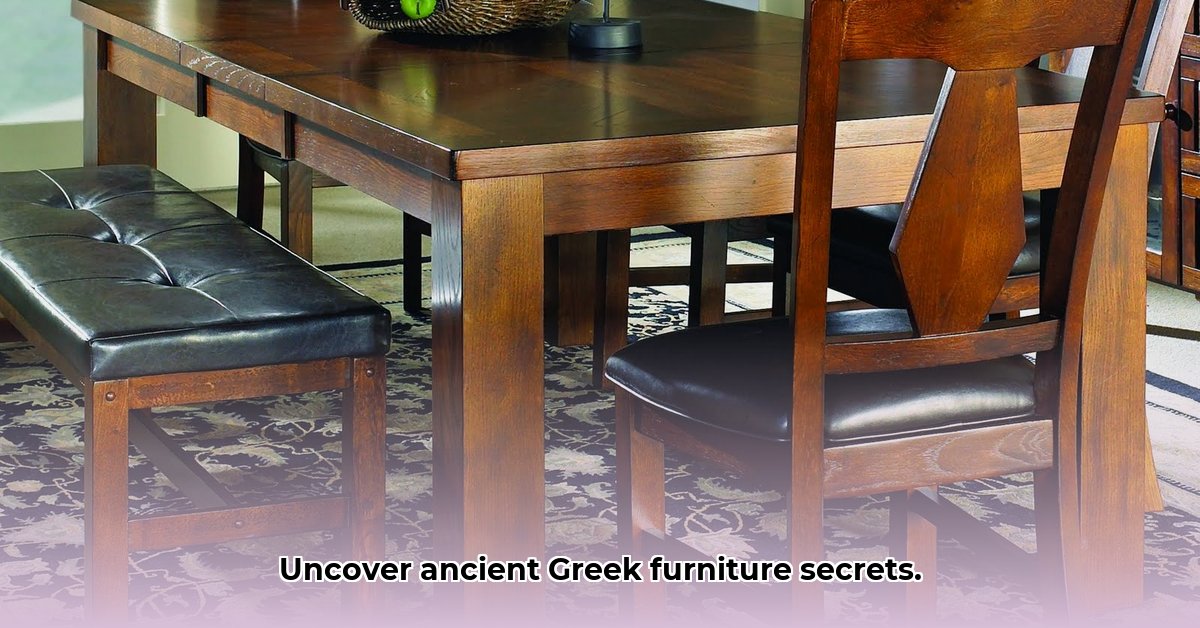Have you ever wondered what it was like to sit down for a meal in ancient Greece? Or what kind of bed a powerful Athenian might have slept on? This is more than just a glimpse at dusty museum pieces; it’s a captivating journey through the lives of ancient Greeks, Egyptians, and Romans, as told through their furniture. We’ll uncover the secrets hidden within wooden chairs, elaborate couches, and even the simplest storage boxes. Explore how these designs reflected their societies and how styles traveled and evolved across cultures. Prepare to view ancient furniture not merely as objects, but as portals to the past, revealing fascinating stories about the people who crafted and used them. For more on ancient Greek art and architecture, see this resource.
Ancient Greek Furniture: A Chronicle of Design and Enduring Influence
Embark on a journey back in time to explore the intriguing world of ancient Greek furniture. Unlike today’s mass-produced pieces from factories, each item was meticulously crafted by skilled artisans, the masters of their era, using locally sourced materials. But how exactly did material availability impact furniture design in ancient Greece?
The Building Blocks: Materials in Ancient Greek Furniture
Wood reigned supreme, featuring robust and beautiful oak, fragrant cedar, resilient olive wood, and sophisticated maple. These materials were favored for their durability and aesthetic appeal. Artisans frequently incorporated metals, with bronze and iron being commonplace, while gold and silver adorned the most luxurious pieces. These metals served not only for structural support but also for adding intricate details and dazzling ornamentation. Stone and ivory were rarer and more expensive, reserved for the elite and their most cherished possessions. Finally, soft and luxurious fabrics like wool and linen provided cushioning for seating and served as elegant drapes, adding comfort and a touch of refinement.
- Wood dominated as the primary material: oak, cedar, olive, and maple.
- Metals, including bronze, iron, gold, and silver, embellished ornamentation.
- Stone and ivory were exclusive to the elite.
- Wool and linen enhanced comfort and added elegance.
Function and Form: Beyond Mere Utility
The design of each furniture piece was intrinsically linked to its intended purpose. A simple, sturdy stool served its practical function unpretentiously. However, a lavish kline, a couch-like piece used for lounging and sleeping, immediately communicated affluence and high social status. Ancient Greek furniture was not just about practicality; it also served as a powerful means of expressing social standing. The evolution of furniture design was not merely about enhancing efficiency; it also reflected shifting cultural values and a burgeoning appreciation for aesthetics. In what ways did function and social status dictate design choices in Greek furniture?
The Iconic Kline: More Than Meets the Eye
The kline arguably holds the title of the most iconic piece of ancient Greek furniture. It wasn’t simply a place to sit or recline; it embodied leisure, hospitality, and social standing. The design of the kline evolved over centuries, reflecting changes in Greek culture. Early versions were straightforward and functional, but later, the klismos, with its graceful curves and slender legs, emerged as a true masterpiece of Greek artistry, reflecting their evolving design sensibilities. Given the kline’s multi-faceted uses, what does it reveal about the social fabric of ancient Greece?
Cultural Exchange: Furniture Beyond Borders
Ancient Greek furniture’s influence extended far beyond its borders. Early Greek designs drew inspiration from the Egyptians, renowned for their imposing and monumental furnishings, such as massive, heavily decorated chairs and beds. However, the Greeks adapted these ideas, refining them with their signature simplicity and elegance. Later, the Romans borrowed from the Greeks, adding their own penchant for opulence and grandeur. This fascinating cross-cultural exchange highlights that while early Greek furniture designs were inspired by the Egyptians, the Romans later adapted Greek styles, resulting in a rich blend of design aesthetics.
Enduring Echoes: Ancient Designs in Modern Furniture
The legacy of ancient Greek furniture endures to this day. The elegant proportions, refined lines, and thoughtful ergonomics (the comfort and practicality of furniture) have profoundly influenced countless contemporary designers. From the graceful curves of a modern chair to the understated elegance of minimalist furniture designs, you can trace echoes of Greek craftsmanship and attention to detail. This timeless appeal is evident both in museum exhibits and in homes that cherish classic and sophisticated design, underscoring the enduring influence of ancient Greek design principles.
Unraveling the Enigma: Ongoing Research and Discoveries
Despite our accumulated knowledge, many questions surrounding ancient Greek furniture remain unanswered. The limited number of surviving pieces and the challenges in accurately dating them mean that continued research is essential. Exciting advancements in imaging technology and ongoing archaeological digs promise to shed light on these artifacts, revealing new insights into their construction, usage, and significance to the people of that era. Advancements in imaging technology are pivotal in uncovering new details about ancient Greek furniture.
Comparative Styles: A Brief Overview
Here’s a concise table that outlines the key differences between ancient Egyptian, Greek, and Roman furniture styles:
| Feature | Egyptian Furniture | Greek Furniture | Roman Furniture |
|---|---|---|---|
| Style | Ornate, monumental, symbolic | Simple, elegant, ergonomic | Blend of Greek elements with Roman opulence |
| Materials | Wood, gold, ivory, precious stones | Wood, bronze, ivory | Wood, marble, bronze, stone |
| Key Piece | Throne, ceremonial beds | Kline, klismos chair | Triclinium (dining couch), ornate tables |
| Overall Aesthetic | Opulent, reflecting power and divinity | Refined, harmonious, and highly functional | Impressive, practical, and reflective of luxury |
The ongoing study of ancient Greek furniture continually enriches our understanding through new discoveries. It’s a compelling reminder of how the past continues to inspire and influence the present.
Dating Techniques for Ancient Roman Furniture: Art, Science, and Context
Accurately dating ancient Roman furniture presents significant challenges, yet researchers use various factors, including artistic depictions and material composition, to better understand these pieces.
Key Takeaways:
- Roman and Greek furniture, though sharing functional parallels, embody distinct cultural values and technological applications.
- Greek designs prioritized elegance, whereas Roman designs emphasized practicality and adaptability.
- Dating Roman furniture heavily relies on indirect evidence from art and literature due to the scarcity of organic material remains.
- Scientific techniques like carbon-14 dating and thermoluminescence are vital but limited by material availability.
- Stylistic analysis, considering regional variations and design trend evolution, is essential for accurate dating.
- Contextual understanding, including social class, geographic location, and historical period, enhances dating accuracy.
The Dating Dilemma: Challenges in Determining Age
Dating ancient Roman furniture presents a formidable challenge because most of it was made of wood—a perishable material. Given this reality, how can we reliably determine the age of something that has largely vanished? We are left to piece together a puzzle from fragments and artistic representations. How does the scarcity of surviving wooden furniture complicate our understanding of Roman design?
Artistic Depictions: Clues Preserved in Visual Culture
Ancient Romans left behind a rich visual record—wall paintings, mosaics, and sculptures often depict furniture in great detail, providing invaluable insights into styles, materials, and construction techniques. Comparing the stylistic characteristics of depicted furniture with surviving fragments allows us to develop a chronological framework. Have you observed the subtle changes in leg designs or the evolution of carving styles? These are the details that historians meticulously analyze.
Material Analysis: Unveiling Secrets Through Scientific Examination
While intact wood remains rare, surviving fragments provide crucial insights, often involving scientific analysis. Carbon-14 dating offers an approximate age for organic materials but isn’t always applicable or precise. Thermoluminescence dating, measuring energy stored in heated materials, can also be used if the wood was exposed to fire.
Stylistic and Contextual Analysis: Assembling the Timeline
Dating involves more than just scientific methods; stylistic analysis is paramount. Researchers examine the forms and decorations of preserved pieces, considering the influence of cultural exchange and technological advancements on style evolution. For instance, the shapes of chairs, tables, and beds changed over time. Regional variations also matter, as fashion in Rome differed from that in Gaul, for example. Understanding the social context in which a piece was used—whether in a wealthy villa or a modest dwelling—influences its likely date.
Refining Our Understanding
The study of ancient Roman furniture underscores the inherent challenges of studying materials. Combining scientific techniques with artistic depictions and historical context allows researchers to reconstruct the story of Roman design and craftsmanship. Each discovery and analysis refines our understanding, enabling us to date these remnants of the past confidently.
Preserving Ancient Greek Furniture: Techniques, Challenges, and Technological Innovations
Preserving ancient Greek furniture requires specialized techniques that account for the delicate nature of surviving pieces.
Key Takeaways:
- Preservation blends traditional methods with modern technological advances to safeguard ancient Greek furniture.
- Understanding material composition is crucial for effective preservation.
- The perishable nature of organic materials like wood presents significant hurdles.
- Modern technologies, such as 3D scanning, offer new preservation opportunities while also posing challenges.
- Collaboration between researchers, museums, and communities is essential for long-term preservation.
The Perishable Past: Wood and its Preservation Challenges
Imagine preserving a delicate wooden chair, thousands of years old, unearthed from an ancient Greek tomb. Unlike stone, wood is highly vulnerable to decay, insects, and climate. How are these irreplaceable artifacts protected and preserved? What measures ensure the longevity of ancient wooden furniture?
Early approaches involved stabilizing the wood, with reconstruction using traditional joinery techniques where possible. This painstaking work requires immense skill and knowledge, akin to assembling an ancient jigsaw puzzle with fragile pieces.
Modern methods add complexity, with consolidants carefully applied. However, the long-term effects of these chemicals require continuous monitoring to prevent unintended damage.
Stone and Marble: Durable Materials, Complex Challenges
Stone and marble, more durable than wood, also present challenges due to weathering, erosion, and vandalism. The Parthenon, despite surviving centuries, requires constant maintenance. What unique challenges do stone and marble furniture present?
Specialized care is essential, including thoroughly researched cleaning methods to prevent irreversible damage. Environmental factors, like pollution, can also erode these structures over time.
The Rise of Technology in Preservation
Powerful technology now aids conservation, with 3D scanning creating detailed digital models for study without handling the originals. This is invaluable for fragile items and aids restoration by referencing digital models. Furthermore, 3D printing can create replicas for display, protecting originals from wear. Is 3D scanning part of the modern preservation of ancient furniture?
Balancing Intervention and Authenticity
The most significant challenge involves determining the appropriate level of intervention. Should we heavily restore a piece, aiming for a pristine aesthetic, or prioritize preserving its original condition, showcasing imperfections? The balance is critical and constantly evolving. How do preservationists balance restoration with maintaining authenticity?
The debate often balances authenticity and stability, with complete restoration potentially obscuring the artifact’s story, while preserving age and damage allows us to better understand its history.
Collaboration and the Future of Preservation
Successful preservation depends on collaboration, including international organizations, museums, government bodies, and local communities. Sharing expertise and resources promotes awareness and builds a stronger commitment. Education is key to informing future generations about preserving our shared heritage. Only through this approach can we ensure these objects endure for centuries.
https://oldentech.com/preservation-techniques-in-greece/
Furniture’s Role in Ancient Greek Domestic Rituals and Ceremonies
Ancient Greek furniture played various roles in homes, from daily use to special ceremonies, as can be gleaned from artifacts and historical records.
Key Takeaways:
- Ancient Greek furniture, mainly wooden, demonstrates artistry, functionality, and social significance.
- Surviving artifacts, literary accounts, and artwork provide insights, despite perishability.
- Key pieces—kline, klismos, and trapeza—illustrate design evolution and social customs.
- Wealthier citizens enjoyed elaborate furniture; simpler pieces served the less affluent.
- The exact construction and function of some pieces remain debated, underscoring study challenges.
- Further research is vital to understanding cultural exchange, design evolution, and symbolic meaning. What further research is needed in the study of domestic rituals and ceremonies pertaining to furniture?
The Humble Kline: More Than Just a Couch
Imagine reclining on a kline, a type of couch that played a crucial role in daily life and ceremonies. During symposia, guests reclined on klinai, conversing and feasting, with the placement conveying social standing. Were these carefully arranged for specific rituals, or were arrangements more about social hierarchies? The limited evidence makes definitive answers challenging.
The Elegant Klismos: A Symbol of Status?
The klismos, with its curved legs, is instantly recognizable and symbolizes refinement. These chairs weren’t everyday items; their presence indicated wealth. Did they feature in ceremonies or hold symbolic meaning? While definitive answers are lacking, pottery depictions suggest their presence in domestic scenes, possibly signaling participation in rituals. What potential meanings did the klismos communicate?
The Trapeza: A Table with Many Roles
The trapeza, a three-legged table, was essential for meals and offerings. Beyond dining, it may have served as an altar for offerings to household deities, supported by artistic depictions and funerary contexts.
The Challenges of Interpretation
Uncovering the precise role of furniture is challenging due to its perishable nature. Artistic depictions and ancient texts help fill gaps, but their accuracy and interpretation remain debatable.
Further Exploration
The study of ancient Greek furniture is ongoing, with new evidence and refined understandings emerging. New technologies, like 3D modeling, create more accurate reconstructions. By combining archaeological, literary, and artistic sources, we unveil the rich cultural context of ancient Greek furniture.















